11 December 2024 : Daily Current Affairs
1. The code of conduct judges need to follow
(Source – The Hindu, International Edition – Page No. – 10)
| Context |
|
Justice Yadav’s Remarks and Public Reaction
- Justice Shekhar Kumar Yadav, a judge of the Allahabad High Court, faced criticism for his remarks at a Vishwa Hindu Parishad event.
- He commented that the country should operate according to the majority population’s wishes and criticised practices like polygamy and triple talaq.
- His speech drew public backlash, with organizations like the All India Lawyers Union calling it undemocratic and leaning towards a “Hindutva Rashtra.”
- Legal advocacy groups have alleged that Justice Yadav’s participation in a politically inclined event and his comments violated judicial ethics.
Supreme Court’s Response
- The Supreme Court acknowledged the media reports on the remarks and sought details from the Allahabad High Court.
- The issue is under consideration by the judiciary, indicating potential future actions.
Judicial Ethics and Codes of Conduct
- The judiciary operates on public trust and its integrity, governed by the ‘Restatement of Values of Judicial Life’ (1997).
- Judges must ensure their behaviour reaffirms faith in judicial impartiality and avoid any action that undermines this perception.
- The Bangalore Principles of Judicial Conduct (2002) mandate that judges maintain public confidence in their impartiality while respecting diversity and equality.
- Judges are required to preserve the dignity of their office and avoid behaviour that compromises judicial independence.
| Bangalore Principles of Judicial Conduct (2002) |
|
Process of Judge Impeachment
- Judges of the Supreme Court and High Courts can be removed for “proved misbehaviour or incapacity” by a Presidential order after impeachment.
- Impeachment requires a special majority in Parliament, with two-thirds of members present and voting in favour.
- The judiciary has an in-house procedure, adopted in 1999, allowing voluntary retirement to avoid public embarrassment.
- Complaints against judges can be addressed to the President, Chief Justice of India, or the relevant High Court Chief Justice.
- Serious allegations are investigated by a fact-finding committee, with recommendations for voluntary retirement or impeachment if necessary.
| Practice Question: Discuss the significance of judicial impartiality in upholding the rule of law. Examine the challenges posed by personal biases in judicial conduct and the adequacy of mechanisms for addressing allegations against judges in India. (250 Words /15 marks) |
2. What is the extent of the global share of solar energy?
(Source – The Hindu, International Edition – Page No. – 10)
| Context |
|
Solar Capacity Growth
- The World Solar Report 2024 by the International Solar Alliance (ISA) reveals that global solar capacity has increased from 1.22 GW in 2000 to 1,419 GW in 2023, achieving a CAGR of 36%.
- Solar energy now accounts for three-quarters of all renewable capacity additions globally.
New Solar Technologies
- Quantum Dot Solar Cells have achieved an efficiency of 18.1%, enhancing energy capture and enabling atmospheric water harvesting.
- Self-healing solar panels are being developed to extend lifespan and reduce maintenance.
- Solar-powered phyto-mining uses solar energy to extract valuable metals from soil, offering a sustainable alternative to traditional mining.
- Solar paver blocks and Building Integrated PV (BIPV), including transparent solar panels, are integrated with infrastructure to allow light transmission and visibility.
- Innovations focus on reducing reliance on critical materials like lithium and rare earth elements while prioritizing panel recycling and circular economy practices.
Reducing Costs and Global Market Trends
- The cost of utility-scale solar PV has consistently fallen, with average auction prices reaching $40/MWh globally.
- India secured the lowest auction price of $34/MWh.
- China dominates the solar PV market, contributing 43% (609 GW) of the global cumulative capacity, with the U.S. at 10% (137.73 GW).
- Solar PV manufacturing saw nearly double the capacity for wafers, cells, and modules in 2023, with China maintaining a dominant market share.
Impact on Other Industries
- Employment in the solar PV sector grew to 7.1 million jobs in 2023, highlighting its economic significance.
- Solar-powered irrigation systems and agrivoltaics are transforming agriculture, with solar pumps expected to grow at 5.8% CAGR from 2021 to 2027.
- Pay-as-you-go business models are increasing solar adoption, especially in developing regions.
Conclusion
- Technological advancements and cost reductions are accelerating the adoption of solar energy, with further focus needed on technology and finance transfer to least developed and small island countries.
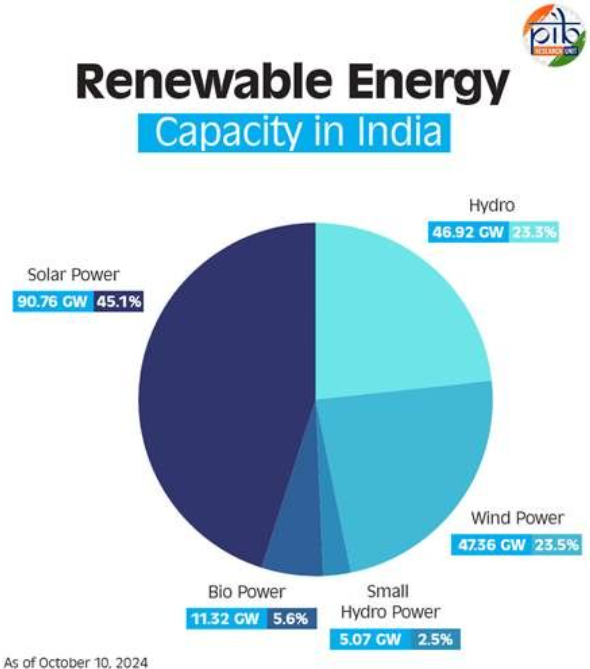
| PYQ: India has immense potential for solar energy though there are regional variations in its development. Elaborate. (250 words/15m) (UPSC CSE (M) GS-1 2020) |
| Practice Question: Discuss the role of technological advancements in reducing the cost of solar energy and its impact on global energy markets. How can emerging solar technologies contribute to sustainable development in India? (250 Words /15 marks) |
3. Centre Urges States to Make Snakebites a Notifiable Disease to Strengthen Surveillance and Reduce Fatalities
(Source: Indian Express; Section: Cover Page; Page: 17)
| Topic: GS3 – Science and technology |
| Context: |
|
Analysis of News:
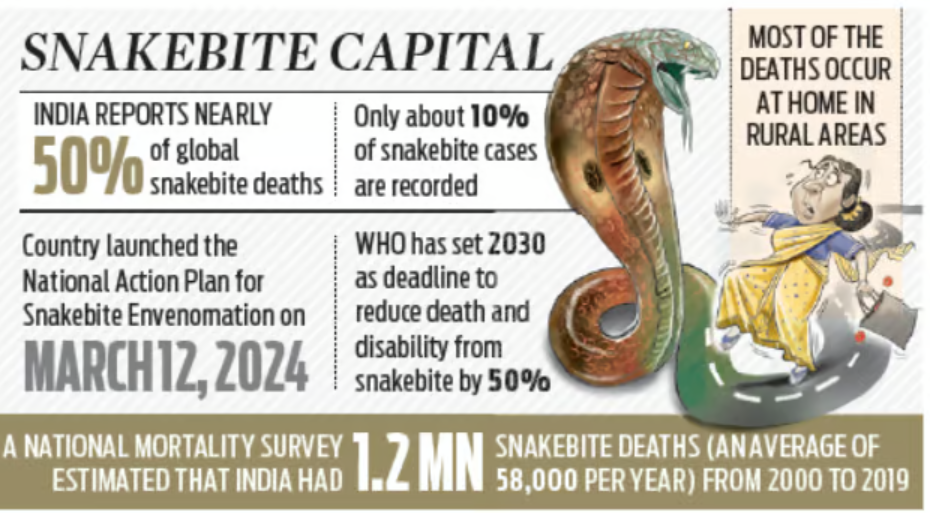
Snakebites: A Public Health Challenge
- Snakebites are a major public health concern in India, with 3–4 million cases annually and an estimated 58,000 deaths according to the 2020 Indian Million Death Study.
- This burden underscores the need for a comprehensive strategy to mitigate snakebite-related fatalities and complications.
- The Union Health Ministry has urged states to make snakebites notifiable, requiring all cases to be reported by private and public hospitals.
Notifiable Diseases
- Notifiable diseases are those that require mandatory reporting due to their potential for outbreaks, mortality, or the need for swift public health responses.
- Common notifiable diseases in India include tuberculosis, malaria, dengue, and HIV.
- Snakebites, though not infectious, qualify due to their acute medical emergencies requiring immediate treatment with antivenom to prevent fatal complications such as paralysis, hemorrhage, or organ damage.
Geographic and Species-Specific Risks
- India is home to over 310 snake species, of which 23 are medically significant. The “Big Four” snakes—Indian cobra, common krait, Russell’s viper, and saw-scaled viper—account for 90% of fatal snakebites.
- Most snakebites occur in low-altitude, densely populated agricultural regions of states like Bihar, Jharkhand, Madhya Pradesh, and Odisha.
Challenges in Managing Snakebites
- Access to Treatment: Victims often rely on faith healers or fail to reach healthcare centers on time, leading to avoidable fatalities.
- Antivenom Limitations: Commercial antivenom is region-specific, with varying effectiveness due to differences in venom composition by geography and snake age. Antivenoms also cause adverse reactions and fail to neutralize venom from certain local species like the banded krait and green pit viper.
- Venom Collection: Venom used for antivenoms is sourced mainly from snakes caught by the Irula tribe, posing logistical and ecological challenges under wildlife protection laws.
Government Initiative: NAPSE
- The National Action Plan for Prevention and Control of Snakebite Envenoming (NAPSE) aims to halve snakebite deaths by 2030.
- It emphasizes making snakebites notifiable to strengthen surveillance, identify high-risk areas, and improve clinical management.
Way Forward
- Enhanced Surveillance: Mandatory reporting can help gauge the true burden of snakebites and identify at-risk regions.
- Improved Antivenom Development: Setting up zonal venom banks and developing synthetic antibodies or peptides could address geographical and species-specific venom variations.
- Community Awareness and Training: Educating communities and training healthcare workers can ensure timely and effective treatment.
Making snakebites notifiable is a critical step toward reducing mortality and improving public health outcomes in vulnerable regions.
| Advantages of notifiable disease |
|
| Practice Question: Discuss the significance of making snakebites a notifiable disease in India. Highlight the challenges in managing snakebite cases and suggest measures to reduce fatalities and improve treatment outcomes. (250 words/15 m) |
4. India’s Foreign Secretary Vikram Misri Visits Dhaka to Strengthen Ties Amid Political Transition and Rising Tensions
(Source: Indian Express; Section: Explained; Page: 17)
| Context: |
|
Analysis of News:
Post-Hasina Scenario
- The collapse of Hasina’s government on August 5 led to widespread chaos, including mob violence targeting symbols of her regime, political figures, and bureaucrats.
- The violence extended to attacks on religious minorities, particularly Hindus, who were seen as aligned with Hasina’s secular policies.
- The unrest also resulted in diplomatic challenges for India, as its cultural center in Dhaka was attacked and Indian diplomats faced threats.
Communal Violence and Minority Concerns
- The fall of Hasina’s government witnessed a rise in communal violence, with incidents targeting Hindus and their establishments.
- Reports highlight over 2,000 communal incidents in August alone, with attacks on places of worship, homes, and businesses.
- The transitional government attempted to assuage minority fears, but tensions reignited following protests by Hindus and the arrest of Hindu monk Chinmoy Krishna Das.
India’s Response and Concerns
- India expressed concerns over the safety of minorities and the security of its diplomatic properties.
- Misri’s discussions with his Bangladeshi counterpart, Mohammad Jashim Uddin, emphasized the need for Dhaka to address these issues while ensuring that bilateral cooperation on development, trade, and connectivity remains unaffected.
Bangladesh’s Pushback
- The interim government, led by Yunus, criticized alleged biases in Indian media and dismissed India’s concerns as interference in Bangladesh’s internal matters.
- Yunus highlighted the potential for strained ties due to statements made by Hasina from India, accusing the new regime of persecuting minorities.
Forward-Looking Diplomacy
- India clarified its stance of maintaining a “people-centric” relationship with Bangladesh, focusing on mutual benefits in trade, energy, and development.
- Misri emphasized constructive engagement with the interim government to steer bilateral ties in a positive direction.
Conclusion
- The visit highlights the challenges in India-Bangladesh relations amid political transition in Dhaka.
- India seeks to balance its concerns for minority welfare and regional stability while ensuring its engagements with Bangladesh remain robust and forward-looking.
| What is the significance of Bangladesh to India? |
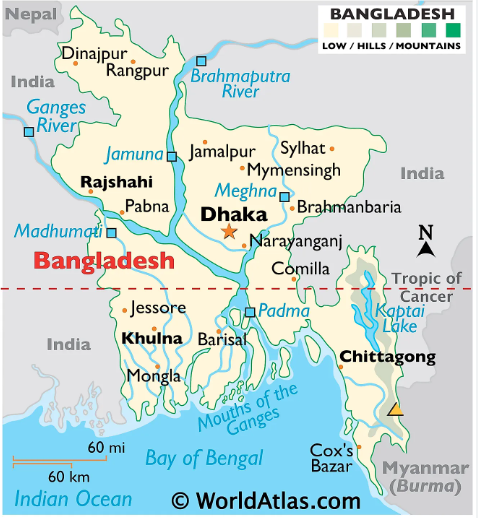 Bangladesh is important to India for several reasons, including Bangladesh is important to India for several reasons, including
|
| Practice Question: Examine the diplomatic significance of Foreign Secretary Vikram Misri’s visit to Dhaka following the collapse of Sheikh Hasina’s government. Discuss the challenges in India-Bangladesh relations and suggest ways to ensure stability and cooperation in the bilateral ties. (250 words/15 m) |
Prelims Facts
1. India Skills Report ranks Kerala among top States for employability in India
(Source – The Hindu, International Edition – Page No. – 3)
| Context |
|
Key Insights from the India Skills Report 2025
- Focus: The India Skills Report 2025 examines the employability of Indian graduates and the evolving talent landscape in the country.
- Methodology: It’s based on data from over 650,000 candidates who took the Wheebox Global Employability Test (GET) and insights from over 1,000 companies.
- Key Findings: The report reveals that 55% of Indian graduates are expected to be globally employable in 2025, highlighting India’s growing role in meeting global workforce demands.
- Domain-Specific Employability: Management graduates show the highest global employability (78%), followed by engineering (71.5%), MCA (71%), and science graduates (58%).
- Regional Trends: Maharashtra, Karnataka, and Delhi are emerging as key talent hubs, with Pune, Bengaluru, and Mumbai leading in skilled workforce availability.
- Gender Dynamics: While the employability rate for men is projected to rise, the rate for women is expected to decline slightly – indicating a need for focused efforts to bridge this gap.
2. Ecologist Madhav Gadgil gets Champions of the Earth award
(Source – The Hindu, International Edition – Page No. – 6)
| Context |
|
Champions of the Earth Award:
- Highest Environmental Honor: It is the United Nations’ top environmental accolade, recognizing outstanding contributions to environmental conservation and sustainable development.
- Established by UNEP: The award is presented annually by the United Nations Environment Programme (UNEP).
- Categories: Recipients are recognized under categories like Policy Leadership, Science and Innovation, Entrepreneurial Vision, Inspiration and Action, and Lifetime Achievement.
- Purpose: The award highlights efforts to combat climate change, protect biodiversity, and promote sustainable practices globally.
- Recipients: Winners include individuals, organizations, and governments demonstrating extraordinary environmental leadership.
- Prestige: The award aims to inspire global action for a sustainable future by spotlighting exceptional environmental achievements.
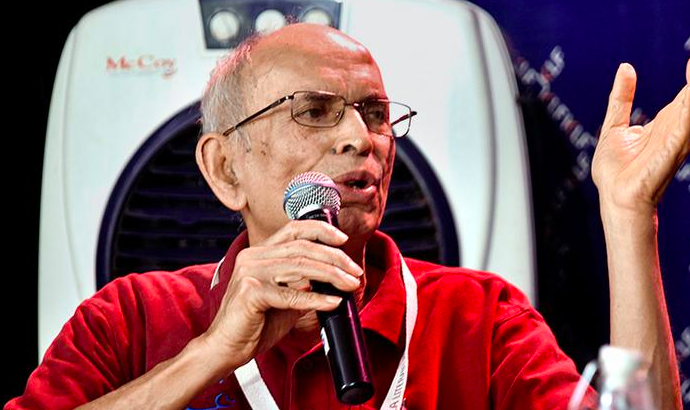
3. Researchers develop AI-based platform to rapidly find age-defying molecules
(Source – The Hindu, International Edition – Page No. – 6)
| Context |
|
Analysis of the news:
- Researchers at IIIT-Delhi have developed AgeXtend, an AI platform to identify molecules with anti-ageing properties.
- AgeXtend screened over 1.1 billion compounds, discovering less than 1% with validated geroprotective effects on yeast, worms (C. elegans), and human cell models.
- The platform uses AI to predict, assess safety, and understand the biological effects of potential anti-ageing compounds.
- AgeXtend can explain its selection process, providing insights into the mechanisms of action for further research.
- It successfully identified the benefits of known molecules like metformin and taurine without prior knowledge of them.
- This study, scanning commercial drugs, Chinese medicine, ayurveda, and FDA-approved molecules, is the largest on the subject.
- The research team has made its code and data freely available for researchers and students, with a charge for companies.
4. Two hominin species ‘existed’ together
(Source – The Hindu, International Edition – Page No. – 7)
| Context |
|
Analysis of the news:
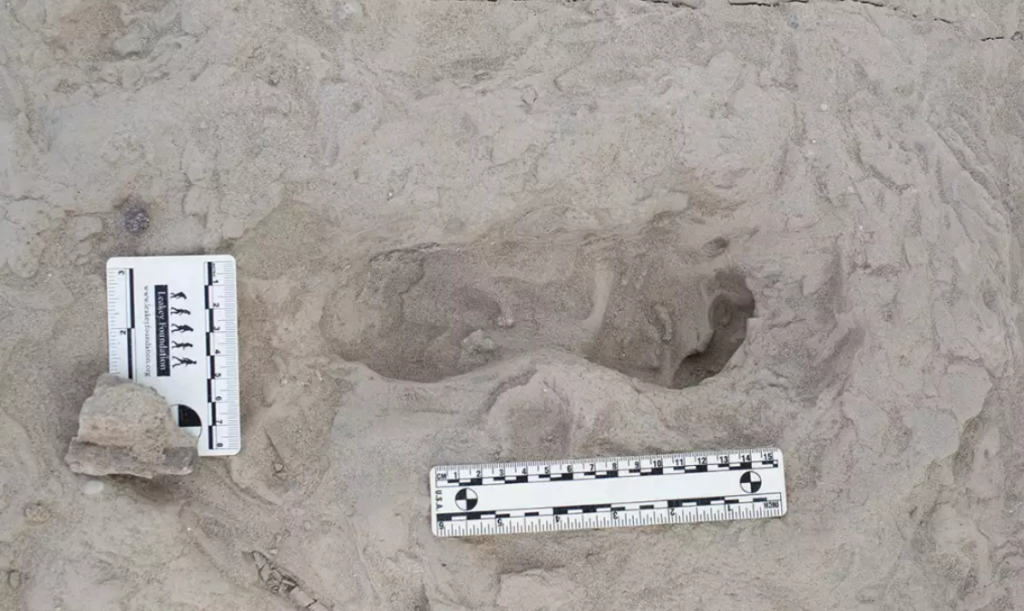
Fossil footprints in Kenya show two ancient human species coexisted
- Researchers have discovered evidence of two distinct hominin species coexisting over a million years ago in present-day Kenya.
- Fossilised footprints dating back 1.5 million years to the Pleistocene Epoch were found near a lake’s shore, providing proof of this coexistence.
- The footprints belong to two species: Homo erectus, an ancestor of modern humans, and Paranthropus boisei.
- These footprints were discovered on soft sediments, preserving a snapshot of their movements in their natural environment.
- Footprints offer unique insights into ancient behaviours and interactions, revealing details not captured by fossilized bones.
- Both species walked upright but had different ecological niches, with one adapted to hunting meat and the other to consuming tough vegetation.
- The findings highlight the complexity of human evolution and the divergent fates of these species, as one survived longer while the other went extinct.
5. India Sees Significant Rise in Female Labour Force Participation, Rural Areas Lead the Way (2017-2023)
(Source: Indian Express; Section: Economy; Page: 15)
| Context: |
|
Analysis of News:
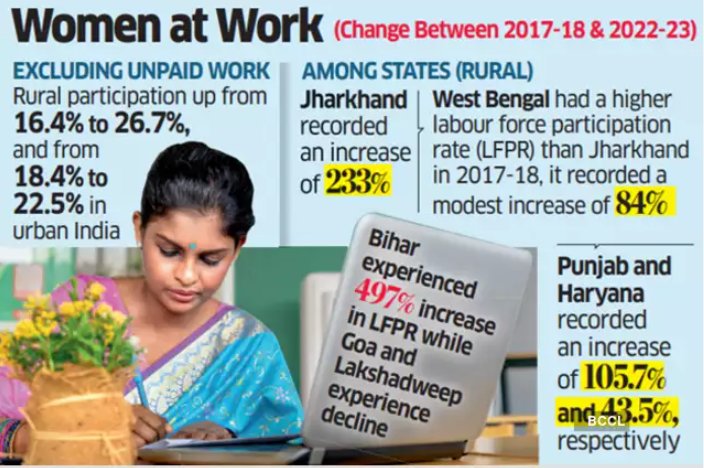
Overview of Female LFPR Trends (2017–18 to 2022–23)
- The female Labour Force Participation Rate (LFPR) in India saw a significant increase across most states during 2017-18 to 2022-23, with rural areas recording larger gains than urban areas.
- According to a working paper by the Economic Advisory Council to the Prime Minister (EAC-PM), rural female LFPR rose by ~69% to 41.5%, while urban LFPR rose to 25.4% from 20.4%.
- Despite these gains, states like Bihar, Punjab, and Haryana continue to exhibit low female LFPR, reflecting stark inter-state variations, even among economically advanced states like Punjab and Haryana.
Key Observations and Trends
Rural vs. Urban Disparities
- The rise in rural female LFPR was more pronounced than in urban areas.
- Factors such as greater engagement in unpaid family work, government schemes, and rural-centric initiatives likely contributed to this trend.
- Urban areas, however, faced challenges like marriage and childcare responsibilities, which significantly reduced female LFPR.
Age and Marital Status Influences
- The female LFPR displayed a bell-shaped curve, peaking at ages 30-40 and declining thereafter.
- Married women, particularly in urban areas, exhibited lower participation rates due to societal and familial roles.
- Conversely, male LFPR remained consistently high (nearly 100%) during ages 30-50, showing less impact from marital or age-related factors.
Regional Variations
- Northern States: Punjab and Haryana recorded persistently low female LFPR despite being among India’s wealthiest regions.
- Eastern States: Rural Bihar reported the lowest LFPR nationally but showed improvement, especially among married rural women.
- Northeastern States: Significant improvements were noted, led by Nagaland and Arunachal Pradesh, reflecting regional socio-economic dynamics.
Role of Government Initiatives
- Schemes like Mudra loans, the Drone Didi initiative, and the Deendayal Antyodaya Yojana have aimed to promote women-led development.
- While the study highlights increased female LFPR, it calls for more rigorous research to determine the direct impact of these schemes on employment trends.
6. Digital Agriculture Mission
(Source – https://pib.gov.in/PressReleseDetail.aspx?PRID=2082787®=3&lang=1 )
| Context |
|
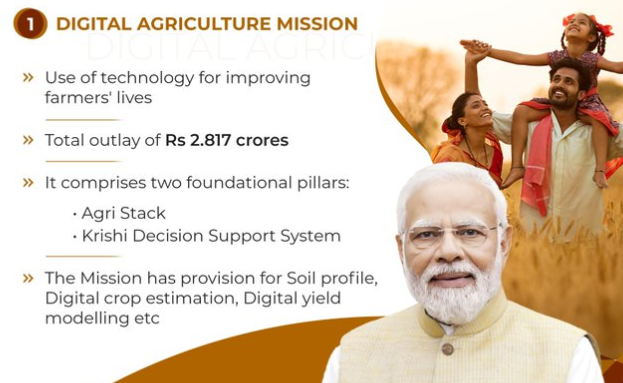
Digital Agriculture Mission:
- The Digital Agriculture Mission was approved on 2nd September 2024 with a budget of Rs. 2817 Crore.
- The mission aims to build a digital system to help farmers with information about crops and provide technology-based solutions.
- It includes building digital tools like Agristack, Krishi Decision Support System, and a Soil Fertility Map to help farmers.
- Agristack is made up of three main parts: a Farmer’s Registry, maps of villages, and a Crop Sown Registry, which are managed by State Governments.
- By December 5, 2024, 29.99 lakh Farmer IDs were created, and crop surveys were done in 436 districts during the Kharif 2024 season.
- The mission uses a federated system, meaning states own the data, and privacy is ensured following the Digital Personal Data Protection (DPDP) Act, 2023.



